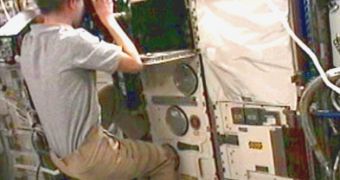Yesterday was a busy day aboard the International Space Station (ISS), as the three astronauts currently making up half of the full Expedition 24 crew prepared to greet their incoming colleagues. Following a reboost procedure that took place on Monday, June 7, the orbital facility was put back on track, and is now ready to receive the Soyuz TMA-19 spacecraft, which will carry astronauts Doug Wheelock and Shannon Walker and cosmonaut Fyodor Yurchikhin. The Russian-built capsule will take off on June 15 and is scheduled to meet up with and dock to the station two days later, Space Fellowship reports.
The three will launch from the Baikonur Cosmodrome, which is a facility operated by the Russian Federal Space Agency (RosCosmos) in Kazakhstan. When they arrive aboard the space lab, the Expedition 24 crew will be completed for the first time. Already waiting in orbit are Commander Alexander Skvortsov and flight engineer Mikhail Kornienko (both from RosCosmos), as well as NASA astronaut Caldwell Dyson. On Tuesday, June 8, the three conducted a series of science and maintenance duties, which were scheduled for completion before the rendezvous with the rest of the team.
In addition to the Soyuz TMA-19 spacecraft, the Expedition 24 crew will also have to dock with a Progress 38 unmanned cargo capsule, which will affix itself to the orbital lab a few weeks later. It will carry science experiments, supplies, spare parts, and food for the astronauts, as well as limited amounts of on-request items, such as movie DVDs and books. Until then, the crew got used to hanging around the station, conducting routine work. The highlight of the day was the removal of some controls from the Rassvet Mini-Research Module (MRM-1), which was installed by the shuttle Atlantis crew in May, during the final mission the orbiter flew for NASA (STS-132).
The ISS, currently orbiting our planet at an altitude of 221.5 x 218 miles, is nearly completed, after more than a decade of assiduous work. Only a few additions remain to be made, including a new Russian-built chamber and an enormous physics experiment, called the Alpha Magnetic Spectrometer (AMS). This is the largest such tool ever flown to space, and it is destined to search for elusive elementary particles and dark matter. Once Endeavor carries it up this November, the station will be completed, and the US shuttle program would have reached its end.

 14 DAY TRIAL //
14 DAY TRIAL //